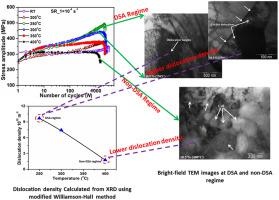International Journal of Pressure Vessels and Piping ( IF 3 ) Pub Date : 2021-08-06 , DOI: 10.1016/j.ijpvp.2021.104529 Girendra Kumar 1, 2 , Ashok Kumar 1 , Himadri Nandan Bar 2

|
In piping structures, the low cycle fatigue loading arises from thermally induced strain cycles associated with start-up and shut-downs and fluctuation in loading conditions. SA333 Gr-6 steel is prone to dynamic strain aging (DSA) and the parameters that govern the DSA are temperature and strain rate. There are limited studies on DSA in the investigated steel. In the present investigation, fatigue experiments were conducted at a fixed strain amplitude of ±0.5 % with the variation of temperatures (RT to 400 °C) and strain rates (1 × 10−4 s−1 to 1 × 10−2 s−1). The results reveal that the cyclic deformation behavior depends on temperatures and strain rates. The steel shows cyclic hardening characteristics at elevated temperatures which indicates the occurrence of the DSA phenomenon. The negative strain rate sensitivity and temperature dependency of stress amplitude are the manifestations of DSA. The present study shows the deleterious effect of DSA on fatigue life. The DSA temperature regime found in the temperature 200–250 °C for 1 × 10−4 s−1 strain rate, 250–300 °C for 1 × 10−3 s−1 strain rate, and 250–350 °C for 1 × 10−2 s−1 strain rate. The DSA regime gets shifted to a higher temperature with the increase in strain rate. Transmission electron microscopy investigations reveal that the fatigue failed specimen at the DSA regime shows severe dislocation activities and dislocation tangles, whereas minor dislocation activities and cell structures were observed at the non-DSA regime. The dislocation density calculated from the X-ray diffraction analysis was higher at DSA compared to the non-DSA regime.
中文翻译:

动态应变时效对管道材料 SA333 Gr-6 钢循环变形的影响
在管道结构中,低周疲劳载荷源于与启动和关闭以及载荷条件波动相关的热致应变循环。SA333 Gr-6 钢容易发生动态应变时效 (DSA),控制 DSA 的参数是温度和应变率。对被调查钢中的 DSA 的研究有限。在本研究中,随着温度(RT 至 400 °C)和应变率(1 × 10 -4 s -1至 1 × 10 -2 s - 1)。结果表明,循环变形行为取决于温度和应变率。该钢在升高的温度下显示出循环硬化特性,这表明发生了 DSA 现象。应力幅值的负应变率敏感性和温度依赖性是 DSA 的表现形式。本研究表明 DSA 对疲劳寿命的有害影响。在温度 200 – 250 °C 1 × 10 -4 s -1应变率、250 – 300 °C 1 × 10 -3 s -1应变率和 250 – 350 °C下发现的 DSA 温度范围1 × 10 -2 秒-1应变率。随着应变速率的增加,DSA 状态转移到更高的温度。透射电子显微镜研究表明,在 DSA 状态下疲劳失效的试样显示出严重的位错活动和位错缠结,而在非 DSA 状态下观察到轻微的位错活动和细胞结构。与非 DSA 方案相比,DSA 的 X 射线衍射分析计算出的位错密度更高。



























 京公网安备 11010802027423号
京公网安备 11010802027423号